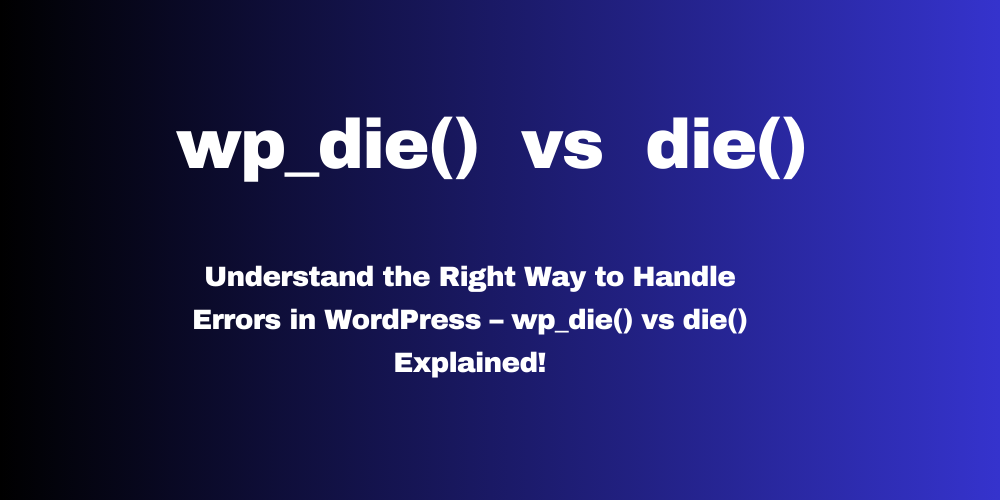Table of Contents Overview Ultimate Auction Pro Auctions Made Easy for WooCommerce Auctions for WooCommerce…
Difference Between wp_die() and die() in WordPress

Table of Contents
- What is die() in WordPress?
- What is wp_die() in WordPress?
- Key Differences Between wp_die() and die()
- Real Code Examples
- When to Use wp_die() Instead of die()
- Conclusion
- FAQ
What is die() in WordPress?
The die() function is a built-in PHP command used to stop script execution immediately. It is basic and outputs plain text without any formatting or styling.
Example Using die():
add_action('init', function() {
if (!current_user_can('manage_options')) {
die('You are not allowed to access this page.');
}
});
This code stops users who aren’t administrators and displays a plain message.
What is wp_die() in WordPress?
The wp_die() function is a WordPress-friendly version of die(). It provides a styled error message and supports HTML, localization, and better error handling.
Example Using wp_die():
add_action('init', function() {
if (!current_user_can('manage_options')) {
wp_die(
__('You are not allowed to access this page.', 'textdomain'),
__('Access Denied', 'textdomain'),
array(
'back_link' => true
)
);
}
});
This displays a WordPress-styled error message with a “Go Back” link and supports translation.
Key Differences Between wp_die() and die()
| Feature | die() | wp_die() |
|---|---|---|
| Basic Function | Stops script | Stops script |
| Output Style | Plain text | Styled WordPress page |
| HTML Support | No | Yes |
| Translation Support | No | Yes |
| Customization | Limited | Customizable with headers, templates, etc. |
| Debug-Friendly | Not really | Yes |
Real Code Examples
Using die() in a Custom Plugin:
function custom_plugin_check_user() {
if (!is_user_logged_in()) {
die('Please log in to access this feature.');
}
}
add_action('wp_loaded', 'custom_plugin_check_user');
Using wp_die() in a Secure Form Handler:
function handle_form_submission() {
if (!isset($_POST['custom_nonce']) || !wp_verify_nonce($_POST['custom_nonce'], 'custom_form_action')) {
wp_die(
__('Security check failed!', 'textdomain'),
__('Error', 'textdomain'),
array('response' => 403)
);
}
// Continue with form processing...
}
add_action('admin_post_custom_form', 'handle_form_submission');
These examples show why wp_die() is more secure, professional, and user-friendly.
When to Use wp_die() Instead of die()
Use wp_die() when:
- Showing error messages to users
- Working inside WordPress plugins or themes
- Handling AJAX requests
- Displaying localized or styled output
Use die() only when you’re working in raw PHP or during early development/testing.
Conclusion
To make sure your WordPress project provides a good user experience and follows WordPress standards, always prefer wp_die() over die(). It’s safer, styled, and more flexible for handling errors properly.
FAQ
What does wp_die() do in WordPress?
wp_die() stops the script and shows a styled WordPress error message. It’s ideal for themes, plugins, and custom development.
Can I use HTML with wp_die()?
You can use HTML tags inside the message to style it or add links and images.
Is wp_die() better than die()?
Yes. It’s designed for WordPress and gives a better user experience with styling and translation support.
Is wp_die() secure?
Yes, it’s safe and even used by WordPress core for security checks and error handling.







This Post Has 0 Comments